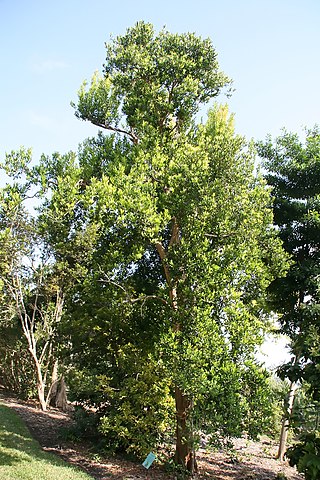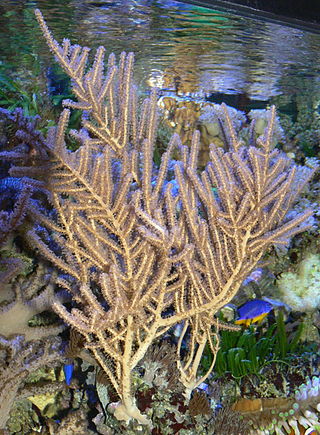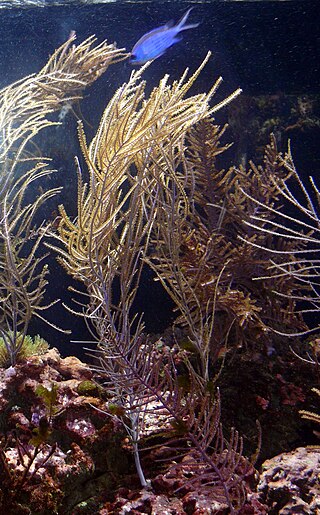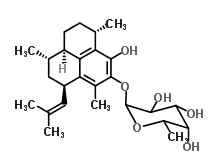
Non-steroidal anti-inflammatory drugs (NSAID) are members of a therapeutic drug class which reduces pain, decreases inflammation, decreases fever, and prevents blood clots. Side effects depend on the specific drug, its dose and duration of use, but largely include an increased risk of gastrointestinal ulcers and bleeds, heart attack, and kidney disease.

A coral reef is an underwater ecosystem characterized by reef-building corals. Reefs are formed of colonies of coral polyps held together by calcium carbonate. Most coral reefs are built from stony corals, whose polyps cluster in groups.

Naproxen, sold under the brand name Aleve among others, is a nonsteroidal anti-inflammatory drug (NSAID) used to treat pain, menstrual cramps, inflammatory diseases such as rheumatoid arthritis, gout and fever. It is taken orally. It is available in immediate and delayed release formulations. Onset of effects is within an hour and lasts for up to twelve hours.
Anti-inflammatory or antiphlogistic is the property of a substance or treatment that reduces inflammation or swelling. Anti-inflammatory drugs, also called anti-inflammatories, make up about half of analgesics. These drugs remedy pain by reducing inflammation as opposed to opioids, which affect the central nervous system to block pain signaling to the brain.

Sargassum is a genus of brown macroalgae (seaweed) in the order Fucales of the Phaeophyceae class. Numerous species are distributed throughout the temperate and tropical oceans of the world, where they generally inhabit shallow water and coral reefs, and the genus is widely known for its planktonic (free-floating) species. Most species within the class Phaeophyceae are predominantly cold-water organisms that benefit from nutrients upwelling, but the genus Sargassum appears to be an exception. Any number of the normally benthic species may take on a planktonic, often pelagic existence after being removed from reefs during rough weather. Two species have become holopelagic—reproducing vegetatively and never attaching to the seafloor during their lifecycles. The Atlantic Ocean's Sargasso Sea was named after the algae, as it hosts a large amount of Sargassum.

Oxaprozin, also known as oxaprozinum, is a nonsteroidal anti-inflammatory drug (NSAID), used to relieve the inflammation, swelling, stiffness, and joint pain associated with osteoarthritis and rheumatoid arthritis. Chemically, it is a propionic acid derivative. Safety and efficacy has been established in children over 6 years with juvenile rheumatoid arthritis only, and there is an increased risk of adverse reactions in the elderly population.

Pimenta racemosa is a species of plant in the myrtle family (Myrtaceae) that is native to the Caribbean region. Common names include West Indian bay tree, bay rum tree, and ciliment.

Meclofenamic acid is a drug used for joint, muscular pain, arthritis and dysmenorrhea. It is a member of the anthranilic acid derivatives class of nonsteroidal anti-inflammatory drugs (NSAIDs) and was approved by the US FDA in 1980. Like other members of the class, it is a cyclooxygenase (COX) inhibitor, preventing the formation of prostaglandins.
Skeletal eroding band (SEB) is a disease of corals that appears as a black or dark gray band that slowly advances over corals, leaving a spotted region of dead coral in its wake. It is the most common disease of corals in the Indian and Pacific Oceans, and is also found in the Red Sea.

White pox disease, first noted in 1996 on coral reefs near the Florida keys, is a coral disease affecting Elkhorn coral throughout the Caribbean. It causes irregular white patches or blotches on the coral that result from the loss of coral tissue. These patches distinguish white pox disease from white band disease which produces a distinctive white band where the coral skeleton has been denuded. The blotches caused by this disease are also clearly differentiated from coral bleaching and scars caused by coral-eating snails. It is very contagious, spreading to nearby coral.

Tritonicula bayeri is a species of dendronotid nudibranch. It is a marine gastropod mollusc in the family Tritoniidae. A number of Caribbean and western Pacific species of Tritonia were moved to a new genus Tritonicula in 2020 as a result of an integrative taxonomic study of the family Tritoniidae.

Capnellene is a naturally occurring tricyclic hydrocarbon derived from Capnella imbricata, a species of soft coral found in Indonesia. Since the 1970s, capnellene has been targeted for synthesis by numerous investigators due to its stereochemistry, functionality, and the interesting geometry of the carbon skeleton. Many alcohol derivatives of capnellene have demonstrated potential as a chemotherapeutic agent with antibacterial, anti-inflammatory and anti-tumor properties.

Gorgoniidae is a family of soft corals, a member of the subclass Octocorallia in the phylum Cnidaria. Nearly all the genera and species are native to the east and west coasts of America.

Pseudopterosin A is a diterpene glycoside isolated from the gorgonian sea whip Antillogorgia elisabethae, found in the Bahamas and Florida Keys. Pseudopterosins A-D, which differ in the degree of acetylation at the sugar ring, were first isolated and reported in 1986. There are at least 25 unique diterpenes isolated from this species of marine animal. Samples of P. elisabethae from the Bahamas are found to have higher concentrations of pseudopterosins than populations from the Florida Keys, which have a greater diversity in diterpene structures.
Elisabethatriene synthase is an enzyme with systematic name geranylgeranyl-diphosphate diphosphate-lyase (elisabethatriene-forming). This enzyme catalyses the following chemical reaction

Curzerene is a volatile, aromatic terpenoid found in many herbs and spices, such as Curcuma zeodaria. It is bioactive isolate of Caribbean corals and is also found in myrrh. More specifically it has been found to make up a significant portion - 12.97% - of the smoke produced from burning Commiphora myrrha oleo gum resin. It is also a major component of myrrh oil, which has been shown in vitro to possess anti-inflammatory properties at sub-toxic by inhibiting the production of the inflammatory cytokine IL-6 by human gingival fibroblasts. Anecdotal evidence exists to support the anti-inflammatory effect of myrrh oil.

Antillogorgia bipinnata, the bipinnate sea plume, is a species of colonial soft coral, a sea fan in the family Gorgoniidae. It is found in the Caribbean Sea. It was first described as Pseudopterogorgia bipinnata in 1864 by the American zoologist Addison Emery Verrill. Williams and Chen (2012), transferred all the Atlantic species of Pseudopterogorgia to Antillogorgia.

Pseudopterogorgia is a genus of soft coral sea fans in the family Gorgoniidae.

Elisabethatriene is a bicyclic compound found in the marine octocoral Pseudopterogorgia elisabethae. Its stereochemistry is identical to the stereochemistry of elisabethatrienol.
Antillogorgia elisabethae is a species of soft coral found in the Caribbean Sea in the shape of a sea plume. It resides from depths of 25 metres (82 ft) to 30 metres (98 ft), often at reef drop-offs. It looks like a plume of feathery appendages with radial symmetry. The branches of A. elisabethae are pinnate and distichous, and will orient themselves in the direction of the ocean current. It ranges in size from 0.3 metres (0.98 ft) to 2 metres (6.6 ft). It is considered commercially important as it is harvested for analgesics and cosmetic creams. The compound that is believed to cause its beneficial effects is Pseudopterosin A, a diterpene glycoside, a selective analgesic. A. elisabethae is also used in fish tanks as a part of the commercial pet industry. The species has a Least Concern conservation status.

















